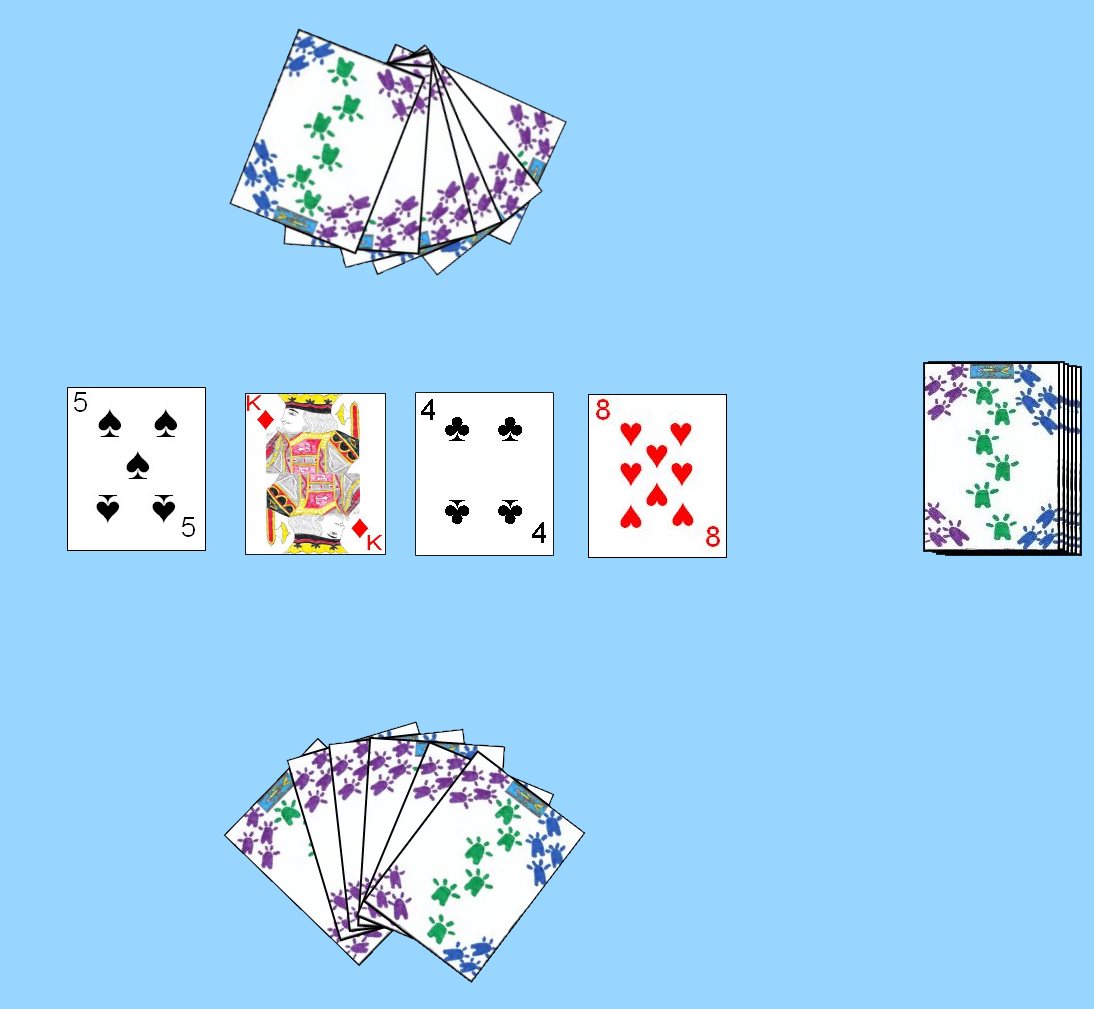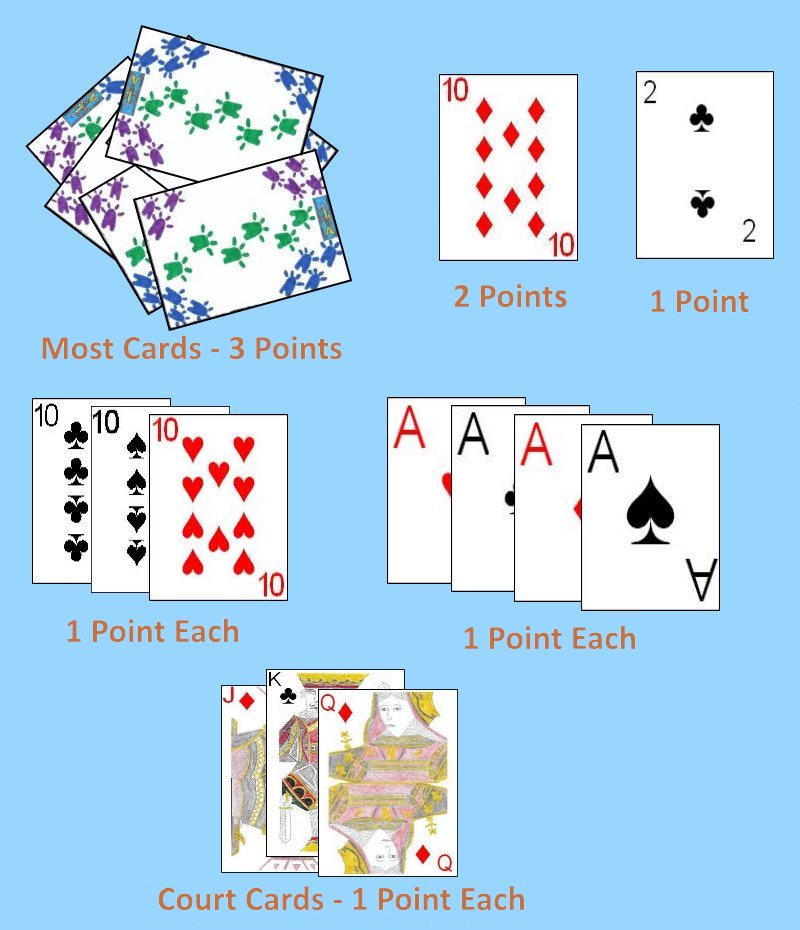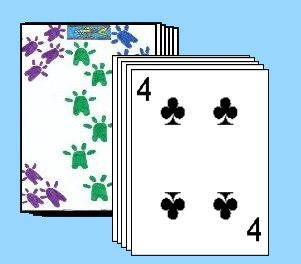Tablanette is a fun game which appears to have originated from the games
Tablić and Tabinet which are commonly played in Serbia and Yugoslavia
respectively. It is a game of the fishing family in which players
attempt to earn points by collecting cards from the center of the table.
As a member of this family of card games, it bears a strong resemblance to many other games of this same type, such as Cassino.
This game is designed for two players using one standard 52 card deck. There is no relative ranking of the cards, however each card in the deck has a counting value for purposes of capturing. The following chart shows the value of each card in the deck:
| Card | Card Sum Value |
|---|
| 2, 3, 4, 5, 6, 7, 8, 9, 10 | Value as Marked on the Card |
| Jack | Special - See Below |
| Queen | 13 |
| King | 14 |
| Ace | 1 or 11 at Holder's Option |
Determination of the first dealer can be performed in a variety of methods with draw for high card a common method (Ace is considered high). If both players draw cards of the same value, they should each draw another card, continuing until each player draws a unique card. After each hand, the role of the dealer alternates amongst the players.

Once the first dealer is determined, he should thoroughly shuffle the cards and offer the deck to his opponent to cut. After the cut, the dealer proceeds to deal out six cards to each player, one by one and face down, distributing the first card to his opponent. After each player has six total cards, the dealer deals four face-up cards to a layout in the center of the table. If any of these cards is a Jack, he should put the Jack at the bottom of the stack, replacing it with a new card from the stock. If this card is also a Jack, he should again place the card at the bottom of the stack and deal a new card to the table to replace it. After dealing the four cards to the layout, he should then place the deck face-down to the side, as it will be used for dealing additional cards to the player throughout the hand.
The non-dealer has the first turn, and the turns thence alternate amongst the two players. A turn consists of a player playing one card face-up from his hand to the table. If the card can capture any cards from the table, he does so as the capture of cards is the object of this game. The following methods can be used to capture cards from the table:
- If the card played has the same rank as any other card on the table, he may take all such cards as well as the card played to capture these cards.
- If two or more cards on the table equal the sum (as per the table above) these cards can be captured, along with the card played to make the capture.
- If a player plays a Jack, he may capture all cards from the table, including the Jack played to make the capture.
A player may capture any and all capturable combinations on the board. A player is never obligated to make a capture if he, for strategic purposes, elects not to. Thus, if the player plays a 9 he may capture another 9 already on the table as well as a 5 and a 4 which would sum to 9, and an additional 7 and 2 which also sum to 9. Note that Aces on the table or from the hand can be considered to have a summation value of 1 or 11 at the player's option during the turn. All cards captured by a player are kept in his own face-down capture pile, which is examined for scoring at the end of the hand.
If a player can make no captures through his play, he must simply play a
card face-up to the center layout. When both players have played the six cards from the hand, the dealer then distributes six more face-down cards to each player (not adding any further cards to the center layout from the stock). After four deals, the deck will become exhausted, ending the hand. After the last card is played, the last player to have captured one or more cards from the table is entitled to capture all remaining face-up cards on the table (this does not, however score for a Tablanette, see below). If no player has yet earned enough points to win the game, another hand is dealt by the dealers opponent.
Tablanettes: If a player, on his turn, manages to capture every
current face-up card on the table (called a Tablanette), he earns bonus
points for this feat. The player should announce this by stating
"Tablanette" and the score for the Tablanette is immediately added to his current score. Playing a Jack, however, does not qualify for this bonus, although the player of a Jack still captures all the cards on the table. The bonus scored from the Tablanette is equal to the total summed value of all cards captured (including the capturing card). Since no more cards will be remaining in the table layout, the opponent will be forced to simply play a card to the table on his own turn.
In addition for scores from Tablanettes, the players also earn points for certain other captures during the hand. After the hand is completed, each player examines his own capture pile and scores points for the following captures:
| Holding | Description | Score |
|---|
| Most Cards | If one player manages to capture more than 26 cards during the hand he is entitled to score for "Cards". If both players capture exactly 26 cards, no one scores for "Cards" on this hand. | 3 |
| 10 of Diamonds (♦) | Capturing the Ten of Diamonds | 2 |
| 2 of Clubs (♣) | Capturing the Two of Clubs | 1 |
| 10 of Clubs, 10 of Spades, 10 of Hearts | Capturing the Ten of Clubs, Ten of Spades, or Ten of Hearts | 1 Point Each |
| Aces | Capturing an Ace | 1 Point Each |
| Court Cards | Capturing a Jack, Queen, or King | 1 Point Each |
|
|

|
After the scores from the hand have been calculated and added to each
player's accumulated score, if any player has scores 251 or more points,
that player is declared the winner. If both players have scores of 251
or over, the player with the higher score is declared the winner.
Thus, during this scoring order, if a player's score totals or exceeds the 251 needed for victory, he is instantly declared the winner of the game.
At any time during the game a player who thinks that they may have totaled 251 or more points in their hand and on the score sheet may call for a "count out". When this is done, immediately this players' captured cards for the hand are examined and
totaled. If their current score sheet total and any points they have won in their already captured cards for the current hand reach or exceed 251 points, this player is immediately declared the winner of the game, regardless of their opponent's score (even it if would be greater than this players). However, if the player falls short of 251, the opponent is immediately declared the winner, no matter what their current score is.
Tablić: Tablić, a Serbian game, appears to be one of the games from which Tablanette was extracted. The rules to this version are similar to Tablanette with the following differences:

- Tablić is designed to be played by two players or four players. When played by four players, it is played as a partnership game, with each player sitting directly opposite his partner at the table. When this partnership version is played, one score is
tallied for each partnership and one player in each partnership should collect all captured cards for that partnership.
- During the deal, cards are dealt to each player in two face-down packets consisting of three cards. These packets of cards are dealt in a counter-clockwise direction around the table.
- After the dealer's opponent cuts, the bottom four cards of the top section of cards from the cut are placed face-up on the table to form the layout (called the talon). The cutter then turns over the entire top half of the cut deck to expose the bottom card such that both players can see it's face. After this the cutter places both parts of the cut deck side by side and the dealer completes the cut, placing the previous bottom cut portion on the top of the deck.
- Jacks which are part of the initial layout are not replaced but left as part of this initial layout, as Jacks in this version do not have any special characteristics.
- The summation values of the cards for capturing purposes are slightly different then in Tablanette. The following chart shows the full value of each card in the deck:
| Card | Card Sum Value |
|---|
| 2, 3, 4, 5, 6, 7, 8, 9, 10 | Value as Marked on the Card |
| Jack | 12 |
| Queen | 13 |
| King | 14 |
| Ace | 1 or 11 at Holder's Option |
- A Jack is considered a standard card, worth a value of 12. Playing a Jack does not automatically entitle a player to capture all cards on the table as it does in Tablanette.
- The rotation of the deal and play is traditionally in a counter-clockwise direction.
- Capturing every card on the table, called a tabla in this game, earns one point for the player managing to do so. This point is immediately added to that player (or teams) on the first six hands of the game. However, on the seventh and later hands, this point is added at the completion of the hand, to
accommodate the play regarding announcing victory (described below). Tablas take the place of the Tablanette as scored in the game Tablanette described above.
- After the last card in the hand has been played, any cards remaining on the table are captured by the dealer. This does not allow the dealer to score for a tabla, however. In fact, a tabla may not be scored on the last card of the hand, even if that last card would normally capture every card on the table.
- The first player (or team) to reach 101 points or more at the end of a hand is declared the winner. If both players (or teams) reach or exceed this score, the player (or team) with the higher score is the winner. If both teams have the same score, another hand must be played to determine the winner.
- If a player (or team) believes they have reached the requisite 101 points during the middle of a hand, they may attempt to declare victory. In this event play is immediately stopped and the captured cards by the announcing teams are examined. If this team has, in fact, scored 101 or more points they are instantly declared the winner of the game,
regardless if the
opposing player (or team) has a higher score. However, if the announcing player or team has less than 101 points, the opposing player (or team) is instantly declared the victors instead. Any tablas scored for the current hand are not included in this calculation.
In all other aspects, including scoring of the various captured cards is the same as in Tablanette as described above.
Tabinet: Tabinet, a Yugoslavian version of Tablić is played identically to that game, with two differences:
The first difference is if the first player to have a turn, after the
initial deal (but before playing any cards), is not satisfied with his
first six cards, may discard these cards to the side and demand a new
hand of six cards. The dealer must honor this request. This only applies
on the first deal of the hand and only for the first player to have a
turn on the hand. The second difference is that, in this game, no player
(or team) may ever
make the victory announcement to declare victory during the hand. All scores are
calculated at the end of the hand, including the additional scores
earned for tablas.
In all other aspects this game is played identically to Tablić.
Copyright © 2015 CatsAtCards.com. All rights reserved.
 Once the first dealer is determined, he should thoroughly shuffle the cards and offer the deck to his opponent to cut. After the cut, the dealer proceeds to deal out six cards to each player, one by one and face down, distributing the first card to his opponent. After each player has six total cards, the dealer deals four face-up cards to a layout in the center of the table. If any of these cards is a Jack, he should put the Jack at the bottom of the stack, replacing it with a new card from the stock. If this card is also a Jack, he should again place the card at the bottom of the stack and deal a new card to the table to replace it. After dealing the four cards to the layout, he should then place the deck face-down to the side, as it will be used for dealing additional cards to the player throughout the hand.
Once the first dealer is determined, he should thoroughly shuffle the cards and offer the deck to his opponent to cut. After the cut, the dealer proceeds to deal out six cards to each player, one by one and face down, distributing the first card to his opponent. After each player has six total cards, the dealer deals four face-up cards to a layout in the center of the table. If any of these cards is a Jack, he should put the Jack at the bottom of the stack, replacing it with a new card from the stock. If this card is also a Jack, he should again place the card at the bottom of the stack and deal a new card to the table to replace it. After dealing the four cards to the layout, he should then place the deck face-down to the side, as it will be used for dealing additional cards to the player throughout the hand.

